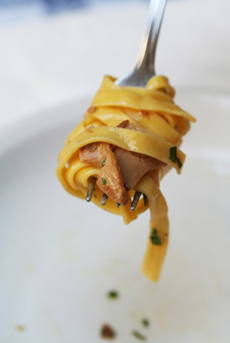TOP PICK OF THE WEEK: Flavored Pasta
|
|
Versatile, economical and a classic comfort food when topped with a tasty sauce and grated cheese: No wonder pasta is at the top of the list of foods beloved by Americans. What is traditionally served as a first course in Italy is most often served as a main course in the U.S.
Colored and flavored pastas have long been available. The most popular are flavored with spinach to create a pale green pasta; with red bell pepper, which results in a pink-colored pasta; and with squid ink, which creates a black pasta. Flavors/colors have traditionally been combined to make a more interesting presentation. Paglia e fieno (straw and hay) is a combination of conventional yellow pasta and spinach pasta; tricolore pasta is a combination of conventional, spinach and red pepper flavors. Over the last thirty years, as chefs and pasta manufacturers have become more creative and consumers have become more adventurous, many different flavors of pasta have appeared. You can find everything from chocolate- and strawberry-flavored pasta to chipotle and wasabi pasta. |
|
|
Al Dente, a pasta company based in Michigan, embraces flavors with some 26 different options in three varieties of ribbon pasta: fettuccine, linguine and pappardelle. The company also makes some of the best pasta sauces out there. Many commercial tomato sauces—even specialty brands—are loaded with unnecessary sugar, which compensates for less flavorful tomatoes and a lack of more expensive spices. Al Dente pasta nails it by using the most flavorful, quality ingredients, eliminating the need to sweeten. The line is certified kosher. Read the full review. A Brief History Of Pasta The Romans lacked tomatoes, which originated in Peru. They did not reach Europe until about 1529, when Spanish Conquistadors returned from Mexico. Initially used as houseplants, they were not eaten until the 1830s! Romans flavored their pasta with honey or tossed it with fish sauce (garum). By the Renaissance, pasta was baked into pies and served as a sweet dish with sugar, cinnamon and other spices (noodle pudding). There were butter sauces, olive oil sauces and cream sauces plus plenty of grated cheese, but only since the 1830s have there been tomato sauces. Continue with a the history of pasta. See the many different different types of pasta.
|
||



